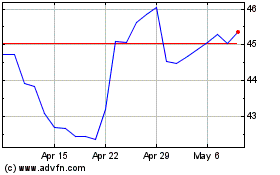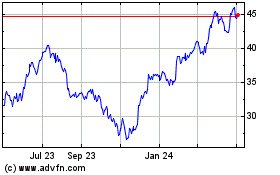By Tim Higgins and Mike Colias
SAN FRANCISCO-- General Motors Co.'s autonomous car unit,
Cruise, revealed a toaster-shaped robot taxi that it says will be
cheaper than taking a human-driven ride-hailing service or driving
a car.
Cruise Chief Executive Dan Ammann on Tuesday said the
all-electric vehicle, called Cruise Origin, was more than a
futuristic vision. "A lot of times, people show these kinds of
concept cars and it's just a thing and maybe it will happen and
maybe it won't," he told reporters, after taking the stage to
reveal the vehicle before hundreds of employees. "This is a fully
engineered vehicle that's on its way to production."
The Origin would be a driverless vehicle, without a steering
wheel and featuring passenger seats facing each other. The
white-and-orange model displayed Tuesday had a roomy interior,
seats for six and doors that slide open like an elevator. While it
looks big, the vehicle takes up the footprint of an average car,
according to Cruise. It was engineered with backup sensors,
computing and other critical features, the company said.
Cars without steering wheels can't legally be on public roads
today. The industry is still working on technical and safety issues
associated with introducing driverless technology.
Mr. Ammann was short on specifics, such as when the vehicles
might be deployed on public streets or exact costs for riders.
Production plans, he said, are due to be announced in a few
days.
GM will build the vehicles while Cruise plans to own and operate
them within its own ride-hailing service.
The boxy, shuttle-like design is reminiscent of the other
vehicles proposed by companies such as Toyota Motor Corp. and
Volkswagen AG. Cruise said the vehicle platform could be configured
for commercial deliveries, another use being pursued by driverless
car developers.
Cruise in recent years has emerged as a leader in
autonomous-vehicle development after landing several large outside
investments and receiving upbeat critiques of its technology from
analysts. The self-driving car unit has raised more than $7
billion, including commitments of more than $2 billion each from
SoftBank Group Corp.'s Vision Fund and Honda Motor Co.
GM in May said Cruise, which is working to develop robotaxis for
ride-hailing services, is valued around $19 billion.
On Tuesday, Mr. Ammann said the average ride-hailing service
costs several dollars a mile while personal car ownership,
depending on the location in the U.S., costs about a dollar a mile.
"Our goal is to deliver something that can beat all of them," he
said.
In recent years, though, the auto industry's enthusiasm for
self-driving cars has been tempered by thorny technical challenges,
safety concerns and a lack of regulations on how these vehicles can
be introduced on public roadways. Some companies have already
pushed back plans to launch commercial services. Predictions made a
few years ago of driverless-taxi services operating in some U.S.
cities by 2020 haven't come to pass.
Today, most companies testing autonomous vehicles on public
roads, as well as a few autonomous shuttle services, include one or
two safety operators to ride along and monitor the system.
Cruise, which has boosted its workforce to 1,700 employees from
about 1,000 at the start of last year, has been relatively quiet
since July, when executives said they would miss a self-imposed
deadline for starting an autonomous-vehicle ride-hailing service
sometime in 2019.
"We're making really rapid progress on the AV performance but
obviously we're still working on something that's never been done,"
Mr. Ammann told reporters Tuesday. The development timeline was
uncertain, he said, adding "but we're moving really quickly."
Driverless-car developers have pressed federal regulators for
rules that would let them deploy vehicles without traditional
steering wheels or foot pedals--equipment designed for human
drivers but not needed in a self-driving car.
A bill that stalled in Congress last year would have directed
regulators to set requirements for autonomous vehicles.
A bipartisan group of lawmakers in Congress is drafting another
bill, staffers say, but the lack of direction from the federal
government is challenging for car companies and startups trying to
advance the technology.
Paul Hemmersbaugh, an attorney at law firm DLA Piper who
specializes in autonomous-vehicle regulation, said some companies
are pulling back on plans to launch vehicles without steering
wheels and pedals and are now considering the use of normal cars
fitted with autonomous systems.
"It's been difficult for [autonomous vehicle] developers to plan
their business models when autonomous vehicles in many instances
are unlawful, or the law is ambiguous," said Mr. Hemmersbaugh, also
a former GM lobbyist.
Two years ago, GM asked the National Highway Traffic Safety
Administration for a waiver to rules that require manual vehicle
controls like brakes and steering wheels. The agency hasn't ruled
on the request.
Cruise and Honda said in 2018 they would jointly develop an
autonomous vehicle that would be built in large volumes for use
globally. Honda committed $2 billion over 12 years for the project
and invested $750 million for an equity stake in Cruise.
GM executives have said the market for autonomous ride-hailing
could exceed $1 trillion, and have suggested that profits from a
future service could exceed that of GM's traditional
vehicle-manufacturing business.
Investors at times have applauded GM's progress on Cruise, even
as record profits from GM's car-making business have failed to
significantly lift the company's share price over the long term.
GM's stock price surged 13% on May 31, 2018, the day the company
announced the SoftBank investment--an unusually big move for a
stock that has been stuck in the mid-$30s in recent years.
GM shares on Tuesday closed down 1.7% at $34.99, before the
vehicle's unveiling.
Mr. Ammann earlier this year attributed the delay in its
robotaxi launch to technical challenges without discussing
specifics, calling the effort to put driverless cars on the road
"the biggest engineering challenge of our generation." He said the
company would focus on logging more test miles and working with the
city of San Francisco--the market where it eventually plans to
introduce service--to educate officials and the public about
autonomous vehicles.
GM Chief Executive Mary Barra in October told analysts during a
conference call that the development of the technology is "very
much on track."
GM has said it was on pace to spend about $1 billion on Cruise
last year.
The company reports fourth-quarter results Feb. 5.
Write to Tim Higgins at Tim.Higgins@WSJ.com and Mike Colias at
Mike.Colias@wsj.com
(END) Dow Jones Newswires
January 22, 2020 00:35 ET (05:35 GMT)
Copyright (c) 2020 Dow Jones & Company, Inc.
General Motors (NYSE:GM)
Historical Stock Chart
From Mar 2024 to Apr 2024

General Motors (NYSE:GM)
Historical Stock Chart
From Apr 2023 to Apr 2024
